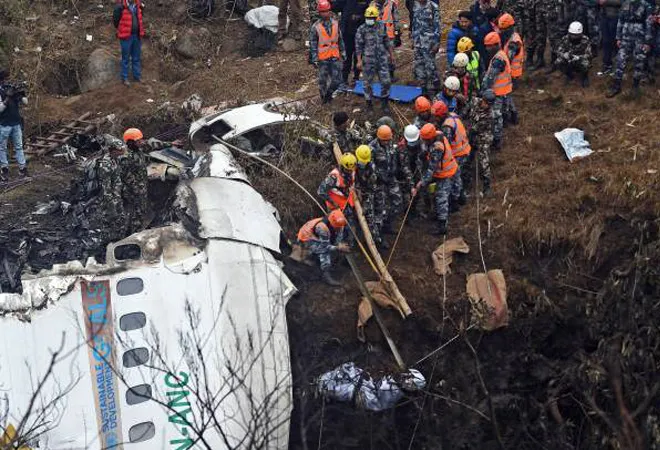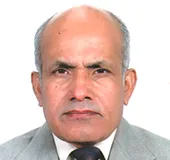
Nepal’s Yeti Airlines plane which was built in 2007 by a French-Italian consortium crashed in Pokhara in the morning hours on 15 January when it was about to land at the recently constructed Pokhara International Airport. The plane flew from Kathmandu to Pokhara (200 kilometres west of Kathmandu). Pokhara is the gateway to the Annapurna Circuit and is the most popular hub for tourists in Nepal. None of the 72 people on board, including 68 passengers and four crew members survived that crash. Of the total passengers on the board, 15 were foreigners, including five Indians, four Russians, two South Koreans and one each from Ireland, Australia, Argentina, and France.
Ever since 1955 when the first air disaster took place in the country, as many as
914 people were killed in different air crashes. The Yeti Airlines crash in Pokhara was
104th in the series and it was the third deadliest one in terms of fatalities. The deadliest air disaster was in 1992 when the Pakistan International Airlines plane that was about to land in Kathmandu collided with the hills where
167 people on board were killed.
The Yeti Airlines crash in Pokhara was 104th in the series and it was the third deadliest one in terms of fatalities.
The Yeti Airlines disaster in Pokhara is the second one in a series in the last nine months, the first one was the disaster of the Tara aircraft that crashed in the Mustang district on 29 May 2022. To mourn the deaths in the plane crash, Yeti Airlines
cancelled all its flights on 16 January. On the same day, the Government of Nepal also declared a holiday to mourn the event. Prime Minister Pushpa Kamal Dahal ‘Prachanda’ called the plane crash a ‘tragic’ event. Indian Prime Minister
Narendra Modi and Uttar Pradesh Chief Minister
Yogi Adityanath expressed deep grief over the loss of lives in the plane crash.
Since the Yeti Airlines plane crashed just 1.6 kilometres off the runway of Pokhara International Airport, it did not take more than 10 minutes for the rescue teams to reach the site. But the teams hardly had
fire brigades, water sources, and other equipment that were needed for the emergency rescue operation. As such, not enough could be done to save the lives of the people.
The
Chief District Officer of Kaski (Pokhara) regarding the Yeti Airlines disaster said, “We lack the tools to deal with emergencies like the one that unfolded... we are short on personal protection equipment for rescuers like safety kits, suits, and fire extinguishers.”
Immediately after the air disaster in Pokhara, the Government of Nepal formed a
five-member accident investigation commission under the coordination of former secretary Nagendra Ghimire to investigate the accident and produce the report within 45 days. In the meantime, the
expert team from France has already started an investigation to find out the reasons behind the plane crash in Pokhara. The newly appointed Minister for Culture, Tourism and Civil Aviation, Sudan Kirati has said that he would pay special attention to ensure
air safety.
The newly built airport that was inaugurated in
haste to meet the deadline of its inauguration by the Prime Minister on 1 January was constructed with financial support from China’s EXIM bank. The impact of the plane crash in Pokhara is already felt. Reports that the number of those
travelling by air has reduced despite the reduction in airfare in different routes.
The newly built airport that was inaugurated in haste to meet the deadline of its inauguration by the Prime Minister on 1 January was constructed with financial support from China’s EXIM bank.
Media reports on the technical lapses confirm that the flight
calibration that tests all pieces of equipment of the airport was not complete at the Pokhara International Airport. Besides, the airport did not have a
grid map that enables the firefighters to reach the destination in the fastest possible manner. The firefighters could reach the crash site late after half an hour.
Just the next day after the air disaster on 16 January, another
aircraft narrowly escaped when it hit a bird at the time of landing at the same Pokhara International Airport. The chances of an aircraft collision with a bird are high at this airport because of its nearness to the landfill site. Again, on 20 January the Nepali Airlines aircraft had to be diverted to Kolkata Airport of India when it could not land at Kathmandu’s Tribhuvan International Airport or the other two newly built airports like the Gautam Buddha International Airport in Bhairahawa or the Pokhara International Airport in Pokhara.
To improve the safety of air passengers, the global aviation watchdogs have asked the civil aviation authority in Nepal to split itself into two separate units like the service provider and the regulator.
Though Nepal is vulnerable to air disasters, the Government of Nepal has never been serious about
emergency rescue and other air safety issues in the country. Considering certain lapses in safety standards, the
European Union has banned all airlines of Nepal from flying into its 27-nation bloc ever since 2013, though the International Civil Aviation Organization declared certain improvements in its safety issues. To improve the safety of air passengers, the global aviation watchdogs have asked the civil aviation authority in Nepal to split itself into two separate units like the
service provider and the regulator.
The Yeti Airlines plane crash has raised an alarm bell for the entire aviation industry in Nepal at a time when the international community are deeply concerned about the poor record of air safety in the country. It cannot be denied that the aviation system of Nepal is poor, and it needs an overhaul. There are technical lapses at most airports despite the difficult geographic terrain. The safety system has been largely compromised. Therefore, the Government of Nepal needs to do a lot to improve aviation safety for which it is expected to address such issues as the lack of adequate infrastructural facilities at the airports, ageing fleet, poor safety regulations, and inadequate training for pilots and air traffic controllers.
The views expressed above belong to the author(s). ORF research and analyses now available on Telegram! Click here to access our curated content — blogs, longforms and interviews.




 PREV
PREV


